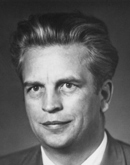

Vilém Kuba
*26. 5. 1905 – Nížkovice, Czech Republic
†20. 5. 1961 – Brno, Czech Republic
Biography
Vilém Kuba, like his older brother, Alois Kuba, studied at the Czech State Industrial School in Brno and completed his internship at the Brno Building Office under architect Bohuslav Fuchs. He gained further experience in the design offices of Oskar Poříský, Jaroslav Rössler, Josef Štěpánek, and Bohumil Hübschmann. At Fuchs' suggestion, he moved to Prague in 1928 to study architecture at the Academy of Fine Arts in the studio of Josef Gočár.
Upon returning to Brno, he fully engaged in architectural practice at the design firm Dvořák and Kuba, significantly influencing the form and typology of rental and family homes in interwar Brno. Vilém Kuba became the chief architect of the firm, ensuring high-quality architectural designs. Many of his realizations in Brno can be recognized by the distinctly overhanging coffered cornices, continuous bay windows, and staircase windows, or opaxit and chamotte cladding on the ground floors and corridors.
In 1932, he and his brother Alois Kuba founded their own design office, V. and A. Kuba. In 1933, the Kubas won 3rd place in a nationwide competition for small apartments, where they presented their well-developed project of "vertical living" in small terraced family houses. In the 1930s, Vilém Kuba successfully participated in other architectural competitions: together with Emanuel Hruška, he won 1st prize for the design of the central cemetery in Prague-Ďáblice and 2nd prize in the competition for a new building of the Czech theater in Brno.
During the occupation, his design activity was minimal. After the war, as an employee of the Building Office of the City of Brno, he was involved in the restoration of war damage. After the communist coup, he became a leader in the Brno Stavoprojekt, which was established by the nationalization of smaller pre-republic firms. Vilém Kuba served here until 1950 as director and then as head of one of the studios. He focused on developing methodologies for post-war construction of new schools or, together with architects Kroha and Polášek, on the construction of apartment buildings and social housing.
In 1957, he, along with J. Ledvin and M. Kramoliš, won the competition for the International Hotel on Husova Street in Brno. This enviable success possibly led to Vilém Kuba not passing the new party vetting processes, and based on a negative personnel assessment, he was dismissed from Stavoprojekt. Despite many appeals, where he proved that he had never owned any property and that his relationship with his brother's firm was purely employment-based, he ultimately had to accept a position as a crane load binder at the Královopolská Machine Works at the age of 53. His situation worsened when he fell ill with cataracts and partially lost his sight. Ultimately, the dangerous job became fatal for him. Vilém Kuba died on May 20, 1961, from the consequences of a serious workplace accident.
Vilém Kuba, like his older brother, Alois Kuba, studied at the Czech State Industrial School in Brno and completed his internship at the Brno Building Office under architect Bohuslav Fuchs. He gained further experience in the design offices of Oskar Poříský, Jaroslav Rössler, Josef Štěpánek, and Bohumil Hübschmann. At Fuchs' suggestion, he moved to Prague in 1928 to study architecture at the Academy of Fine Arts in the studio of Josef Gočár.
Upon returning to Brno, he fully engaged in architectural practice at the design firm Dvořák and Kuba, significantly influencing the form and typology of rental and family homes in interwar Brno. Vilém Kuba became the chief architect of the firm, ensuring high-quality architectural designs. Many of his realizations in Brno can be recognized by the distinctly overhanging coffered cornices, continuous bay windows, and staircase windows, or opaxit and chamotte cladding on the ground floors and corridors.
In 1932, he and his brother Alois Kuba founded their own design office, V. and A. Kuba. In 1933, the Kubas won 3rd place in a nationwide competition for small apartments, where they presented their well-developed project of "vertical living" in small terraced family houses. In the 1930s, Vilém Kuba successfully participated in other architectural competitions: together with Emanuel Hruška, he won 1st prize for the design of the central cemetery in Prague-Ďáblice and 2nd prize in the competition for a new building of the Czech theater in Brno.
During the occupation, his design activity was minimal. After the war, as an employee of the Building Office of the City of Brno, he was involved in the restoration of war damage. After the communist coup, he became a leader in the Brno Stavoprojekt, which was established by the nationalization of smaller pre-republic firms. Vilém Kuba served here until 1950 as director and then as head of one of the studios. He focused on developing methodologies for post-war construction of new schools or, together with architects Kroha and Polášek, on the construction of apartment buildings and social housing.
In 1957, he, along with J. Ledvin and M. Kramoliš, won the competition for the International Hotel on Husova Street in Brno. This enviable success possibly led to Vilém Kuba not passing the new party vetting processes, and based on a negative personnel assessment, he was dismissed from Stavoprojekt. Despite many appeals, where he proved that he had never owned any property and that his relationship with his brother's firm was purely employment-based, he ultimately had to accept a position as a crane load binder at the Královopolská Machine Works at the age of 53. His situation worsened when he fell ill with cataracts and partially lost his sight. Ultimately, the dangerous job became fatal for him. Vilém Kuba died on May 20, 1961, from the consequences of a serious workplace accident.
The English translation is powered by AI tool. Switch to Czech to view the original text source.






